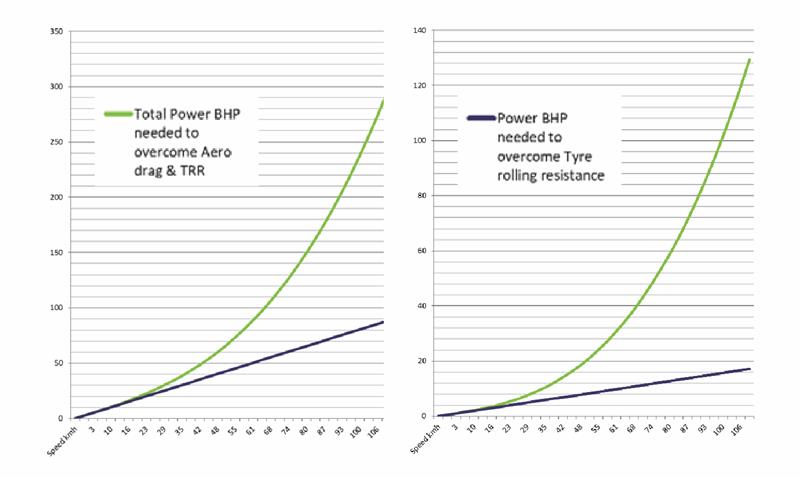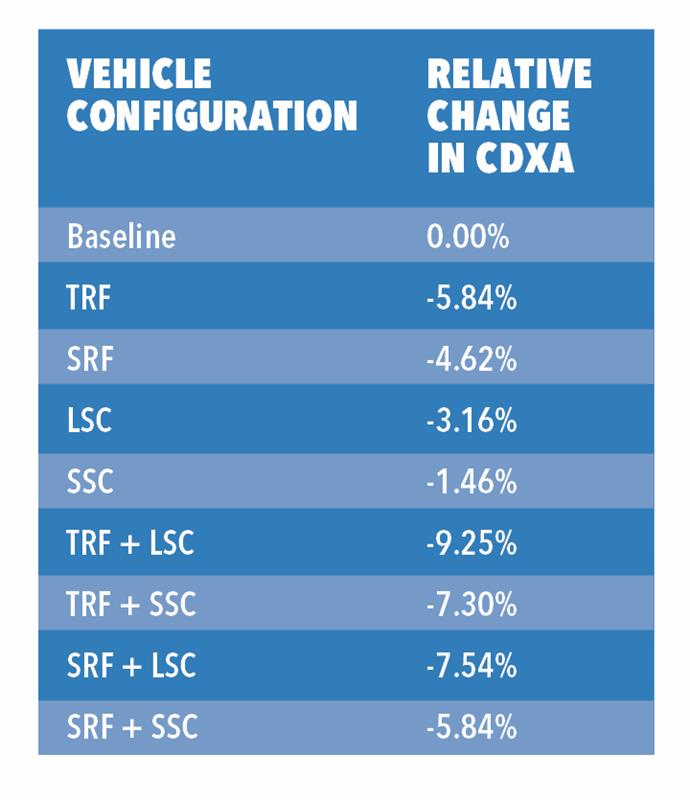
As the European Commission says, “Since the CO2 emissions related to trailers have a strong impact on the overall CO2 emissions and energy consumption of motor vehicles, respective targets for the trailers should also be defined.”
VECTO is currently being used on tractors, with the aim of reducing a brand’s average CO2 emissions by 15% from the 2019-2020 reference figures by 2025, and by 30% by 2030. In the UK, DfT has not yet announced when it might implement the scheme.
The EC is not expecting manufacturers to test or simulate the environmental performance of their trailers or bodywork themselves: a comprehensive assessment of a single design might take several days at a testing facility, costing tens of thousands of pounds. Even a CFD (computational fluid dynamics) simulation of the aerodynamics of a design, along with assessment of the running gear, would be a significant overhead.
Instead, VECTO uses a set of predetermined data to calculate the environmental performance of the trailer. This includes its dimensions and shape, the running gear fitted and whether any aerodynamic aids have been added.
Running gear has a direct effect on fuel consumption, so the model specifies wheel and tyre sizes, single/dual wheels, axle positions and whether axles lift and/or steer. These components are separately certified by their manufacturers, although to limit costs, they can group related components into ‘families’. If components have not been certified, generic ‘standard’ values are available.
The VECTO regulations are being extended to trailers with a maximum mass of at least 8,000kg (so categories O3 — except trailers from 3.5t to just under 8t — and O4), with the following exceptions: ‘vehicles with a bodywork other than a box shaped bodywork’, trailers with more than three axles, link drawbar trailers, link semi-trailers and converter dollies, oversize trailers andtrailers with driven axles.
By ‘box shaped bodywork’ the Commission means: dry box (such as the Tiger Trailers body pictured above), refrigerated, curtainsided and dropside tarpaulin body.
The regulations also define ‘volume-oriented’ trailers as being ‘primarily designed for the transport of voluminous goods’ and having an internal height of at least 2.9m.
How many trailers conform to the ‘box’ shape? UK-based consultancy CLEAR International compiles figures for sales and for the parc of trailers across Europe. The 2022 figures for Western Europe suggest that curtainsiders, closed boxes and reefers make up 59% of the market.
TOOLED UP
The data and identifying information can be put into a ‘simulation tool’ provided by the European Commission and operated by the manufacturer or a consultant. However, “to ensure that the environmental performance is correctly simulated, approval authorities should assess and monitor the handling of data… and the proper use of the simulation tool” (see www.is.gd/lanira).
The simulation tool produces a ‘customer information file’ (CIF) with a unique ‘cryptographic hash’ or identifying code which ensures that it has not been tampered with. The CIF is used with the PC-based VECTO program to predict fuel consumption at a particular speed and weight, on a specific type of operation, or ‘mission profile’.
The fuel consumption results from VECTO are given in absolute terms (for example, litre/100km) and in relative terms both by payload (g/t-km) and by load volume (g/m3-km). This is an improvement on earlier models, which only gave the absolute fuel consumption and did not take into account the load-carrying efficiency of a vehicle.
It also calculates CO2 output (again relative to payload and volume) and produces an ‘efficiency ratio’ comparing the carbon output to a ‘reference’ trailer — useful for seeing if a particular combination of dimensions and components works well.
The VECTO figures are not just intended for customers: the CIF can also be used for road tolling and taxation purposes. And an amendment which appeared in February this year (www.is.gd/qohecu) shows that the Commission intends to reduce CO2 emissions due to trailers, relative to the reference figures from 2019-20.
The reduction isn’t quite as stringent or immediate as the cut for trucks and buses: while most heavy trucks will have to show a 15% cut in CO2 emissions from 2025 (going up to 43% in 2030, 64% in 2035 and 90% in 2040), semi-trailers are required to see a reduction of 15% by 2030 and beyond (7.5% for other trailers). This figure does not increase beyond 2030.
There is no indication of what the penalties for non-compliance might be. This is more complicated than for truck makers, who will be hit by sizeable charges (€4,250 per g/t-km per truck) if their vehicles don’t meet emissions targets by 2025, and even more in 2030.
A recent document from consulting group Applus IDIADA details how the simulation and validation were done. It used CFD to predict the aerodynamic resistance (CDxA) of a large number of different vehicle configurations “to build… the algorithms and equations…to return an estimated drag resistance value for a given trailer or semi-trailer… purely based on vehicle dimensions”.
To ensure that the CFD simulation was accurate, a volume of space some 200 x 100 x 50m around and above the truck itself had to be modelled, with around 100 million cells. The simulation was performed at a vehicle speed of 90kph, with yaw angle (the angle of the wind flow to the vehicle) at 0°, 3°, 6° and 9°. It was also performed with each possible combination of aerodynamic aids: tall (TRF) or short rear flaps (SRF), long (LSC) or short side covers (SSC), or none at all (see also box, right).
To validate the CFD methodology, IDIADA ran tests at a Spanish proving ground using an IVECO Stralis 460E Hi-Way Cabin (later, a 2019 Stralis 570) pulling a standard Schmitz Cargobull box semi-trailer. This was then combined with a variety of aerodynamic devices.
AERODYNAMIC DEVICES
The CFD results show that aerodynamic aids have a genuine impact: the effective frontal area (CdxA) changes are listed in the table on p14. These figures are for a ‘volume-oriented’ semi-trailer, and for a yaw angle of 0°. The combination of tall rear flaps and long side skirts (TRF+LSC) reduces drag by 9.25%. At high yaw angles (that is, sidewinds) the effects are greater still: at 9° yaw, the TRF+LSC combination cuts drag by over 15% relative to the baseline.
However, some industry figures have their doubts. Richard Owens, marketing manager at Don-Bur, says: “We know that skirts are going to realise a fuel saving of maybe 2 or 2.5% realistically, but they cost something like £3,000… You’re expecting a payback period of maybe three years, so you've got to really look after them, and the chances are the skirts are going to get damaged. You’re looking at a repair bill, and that’s wiped out all of the fuel savings.”
Owens also has doubts about the limitations of VECTO itself: “We like the idea, and from a CSR point of view we endorse it, because it makes sense. But do you value the CO2 output of a trailer — effectively what VECTO does — or do you look at… the environmental impact of moving goods from A to B irrespective of method? I think if you start looking at that question holistically then VECTO starts to look less impressive.”
Owens adds: “In a European environment where trailer is a trailer is a trailer, VECTO becomes quite a good lever to understand what you’re buying in terms of efficiency. But the UK market is very different in terms of what it offers.” For example, VECTO does not (at least initially) cover front bulkhead domes, or ‘teardrop’ trailers — manufacturers will have to generate their own CFD and/or experimental data to prove their environmental credentials.
BOX: Aerodyne on aerodynamics

Aerodynamic device manufacturer Aerodyne demonstrates the importance of drag at low speeds in the case of rigid vehicles. It writes: “When a truck moves, the engine has to combat three main forces:
-Drivetrain friction – the loss of power in the drive train, an area in which all truck manufacturers are striving to improve efficiencies and which our aerodynamic kit cannot help
-Tyre rolling resistance – this relates to the weight of the vehicle. The heavier it is, the more the power needed to move it
-Aerodynamic drag – this relates to the shape of the vehicle and how it moves through the air when travelling. This force is easy to test.
“As a vehicle doubles its speed, it needs twice the power to overcome its weight and eight times the power to overcome aerodynamic drag. Put another way, the vehicle behaves as if it is heavier the faster it travels.
“This can be depicted in graph form, for sample vehicles. In the graphs, the vertical axis shows the engine power required (in BHP). The horizontal axis shows the vehicle speed.
“For a sample 18-tonne rigid vehicle [pictured at left], aerodynamic drag starts to use engine power at around 18kph. At 50kph, 40bhp is being used to overcome weight and 20bhp aero drag. Using the same scenario but for a 3.5-tonne vehicle, at 50kph, only 8bhp (42%) is being used to overcome weight … but 11bhp (58%) of the engine power is overcoming aero drag. This graph [below] shows a dramatic increase in aerodynamic drag between 16 and 50kph, the most common speed range at which these trucks operate. In fact, the lighter the vehicle, the lower the speed required to see a benefit from aerodynamic improvements.”
BOX: Definitions of aerodynamic devices

According to the VECTO legislation (www.is.gd/lanira) the “standard aerodynamic devices… for which standard values can be used in the vehicle certification” comprise:
Rear flaps are defined as “two or more rear fairing panels located at the rear end of the vehicle with the aim to reduce its wake”.
Short rear flaps (SRF) have lateral panels measuring “at least two metres and do not cover the total height of the body”.
Tall rear flaps (TRF) have lateral panels covering “the entire height of the body with a tolerance of ±3% of the total height of the body”.
Side covers are defined as “panels located at the lower side of the vehicle with the aim to reduce the impact of crosswind and/or the turbulences created by the wheels on the air drag”.
Short side covers (SSC) do not cover the wheels; on semi-trailers, “they cover only the distance between the landing gear and the beginning of the first wheel”.
Long side covers (LSC) cover the distance between the landing gear and the rear end of the semi-trailer.
VECTO does not allow for full ‘boattails’ like those seen on the recent US SuperTruck II concepts.







